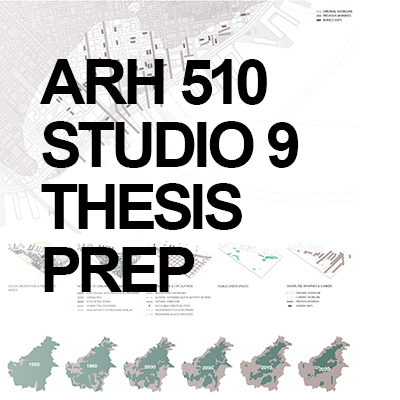
ARH 510 Studio 9 Thesis Preparation and Development
Cultivate your point of view using architecture as a lens. You’ll conduct research-driven architectural investigations to identify your thesis topic, develop your architectural language, and use site and demographic analysis as design criteria for the final thesis project in the subsequent semester.
Prerequisites: ARH 410, ARH 420, ARH 440, ARH 450, LA 292, LA 429, LA 449 & ARH 529 (ARH 529 must be taken concurrently)
Course Learning Outcomes
- Position a thesis project within the history and theory of architectural discourse supported by a bibliography. Expand and curate a reference library of contemporary architecture as a living document for the duration of the thesis project and beyond
- Identify design problems based on critical research of exigent contemporary issues such as climate adaptation, environmental justice, equity and inclusion
- Substantiate with thoroughly cited research how the program selection serves an unmet need at the site
- Substantiate site selection criteria with thoroughly cited research and demonstrate how the criteria addresses ethical considerations for environmental stewardship and equity
- Revise thesis statements by iteratively testing architectural responses to site and cultural contexts
- Develop an architectural language through formal analyses of precedent buildings and by iteratively testing appropriateness for the selected site, climate, program, user groups
- Justify an architectural language by demonstrating how it meets user needs, aligns with thesis intent, and embodies a meaningful contribution to the discipline of architecture
NAAB Criteria
- This course addresses NAAB PC.5 Research & Innovation: How the program prepares students to engage and participate in architectural research to test and evaluate innovations in the field
- This course addresses NAAB Shared Values of Knowledge & Innovation: Architects create and disseminate knowledge focused on design and the built environment in response to ever-changing conditions. New knowledge advances architecture as a cultural force, drives innovation, and prompts the continuous improvement of the discipline
